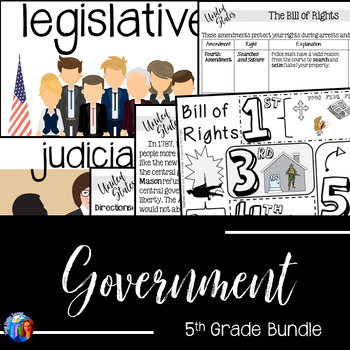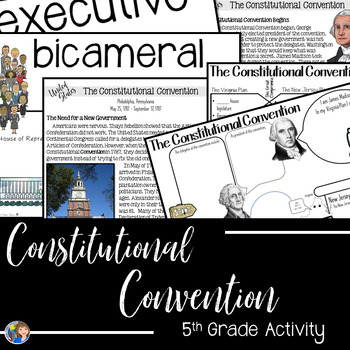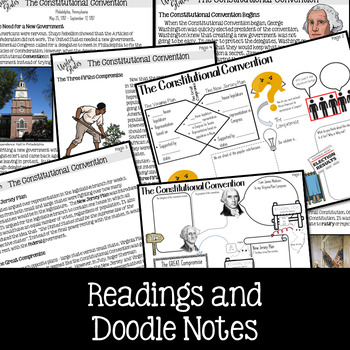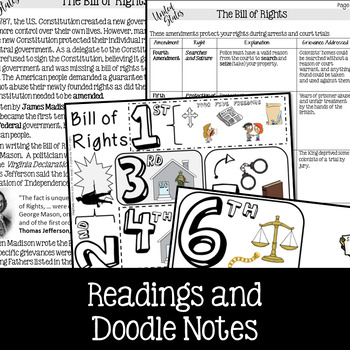Government Activities for 5th Grade Social Studies
- Zip
- Google Apps™

What educators are saying
Products in this Bundle (13)
showing 1-5 of 13 products
Description
Bring government to life with these exciting lessons for 5th grade! Your students will read, debate, and play games as they learn about the government of the United States. Each resource is designed to engage students with a variety of activities including Word Wall Terms, Vocabulary Activities, Doodle Notes, card sorts, reading and writing assignments, and games! Rich in primary sources and information text, this bundle will make teaching 5th grade Social Studies easier for you!
⭐Please download the preview to see more information on this resource. ⭐
Doodle notes is a trademarked term used with permission. Please visit doodlenotes.org for more information.
5th Grade Social Studies TEKS
(3) History. The student understands the significant individuals who contributed to the creation of the U.S. Constitution and the government it established. The student is expected to identify the contributions of Founding Fathers James Madison and George Mason who helped create the U.S. Constitution.
(14) Government. The student understands important ideas in the Declaration of Independence, the U.S. Constitution, and the Bill of Rights. The student is expected to:
(C) explain the reasons for the creation of the Bill of Rights and its importance.
(15) Government. The student understands the framework of government created by the U.S. Constitution of 1787. The student is expected to:
(A) identify ... the three branches of government;
(B) identify the reasons for and describe the system of checks and balances outlined in the U.S. Constitution; and
(16) Citizenship. The student understands important symbols, customs, celebrations, and landmarks that represent American beliefs and principles that contribute to our national identity. The student is expected to:
(A) explain various patriotic symbols, including Uncle Sam; national celebrations such as Labor Day; and political symbols such as the donkey and elephant;
(18) Citizenship. The student understands the importance of effective leadership in a constitutional republic. The student is expected to:
(A) identify past and present leaders in the national government, including the president and various members of Congress, and their political parties; and
(B) identify leadership qualities of national leaders, past and present.
(19) Citizenship. The student understands the fundamental rights of American citizens guaranteed in the Bill of Rights. The student is expected to describe the fundamental rights guaranteed in the Bill of Rights, including freedom of religion, speech, and press; the right to assemble and petition the government; the right to keep and bear arms; the right to trial by jury; and the right to an attorney.
(23) Social studies skills. The student applies critical-thinking skills to organize and use information acquired from a variety of valid sources, including technology. The student is expected to:
(A) differentiate between, locate, and use valid primary and secondary sources such as technology; interviews; biographies; oral, print, and visual material; documents; and artifacts to acquire information about the United States;
(B) analyze information by applying absolute and relative chronology through sequencing, categorizing, identifying cause-and-effect relationships, comparing, contrasting, finding the main idea, summarizing, making generalizations and predictions, and drawing inferences and conclusions;
(C) organize and interpret information in outlines, reports, databases, and visuals, including graphs, charts, timelines, and maps;
********************************************************************
➬Customer Tips:
How to get TPT credit to use on future purchases:
• Please go to your My Purchases page (you may need to login). Beside each purchase you'll see a Provide Feedback button. Simply click it and you will be taken to a page where you can give a quick rating and leave a short comment for the product. Each time you give feedback, TPT gives you feedback credits that you use to lower the cost of your future purchases. I value your feedback greatly as it helps me determine which products are most valuable for your classroom so I can create more for you. ☺
Be the first to know about my new discounts, freebies and product launches:
• Look for the green star next to my store logo and click it to become a follower. You will now receive email updates about this store. ☺
© Social Studies Success, LLC. This purchase is for you and your classroom. Duplication for an entire school, an entire school system, or for commercial purposes is strictly forbidden. Please have other teachers purchase their own copy. If you are a school or district interested in purchasing several licenses, please contact me for a district-wide quote. Do not share this document with Amazon Inspire.
Please review all product descriptions and previews. If you have a question, contact me before you purchase at SocialStudiesSuccess1@gmail.com. As this is a digital product, all sales are final.
❤️ Dawn





